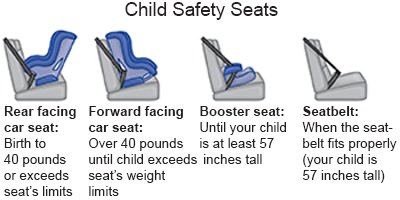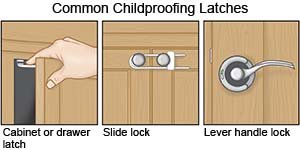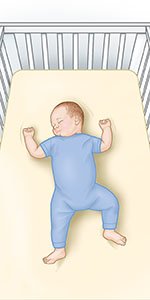Well Child Visit at 6 Months
Medically reviewed by Drugs.com. Last updated on Apr 6, 2025.
What is a well child visit?
A well child visit is when your child sees a healthcare provider to prevent health problems. Well child visits are used to track your child's growth and development. It is also a time for you to ask questions and to get information on how to keep your child safe. Write down your questions so you remember to ask them. Your child should have regular well child visits from birth to 17 years.
What development milestones may my baby reach at 6 months?
Each baby develops at his or her own pace. Your baby might have already reached the following milestones, or he or she may reach them later:
- Babble (make sounds like he or she is trying to say words)
- Reach for objects and grasp them, or use his or her fingers to rake an object and pick it up
- Understand that a dropped object did not disappear
- Pass objects from one hand to the other
- Roll from back to front and front to back
- Sit if he or she is supported or in a high chair
- Start getting teeth
- Sleep for 6 to 8 hours every night
- Crawl, or move around by lying on his or her stomach and pulling with his or her forearms
What can I do to keep my baby safe in the car?
- Always place your baby in a rear-facing car seat. Choose a seat that meets the Federal Motor Vehicle Safety Standard 213. Make sure the child safety seat has a harness and clip. Also make sure that the harness and clips fit snugly against your baby. There should be no more than a finger width of space between the strap and your baby's chest. Ask your healthcare provider for more information on car safety seats.

- Always put your baby's car seat in the back seat. Never put your baby's car seat in the front. This will help prevent him or her from being injured in an accident.
What can I do to keep my baby safe at home?
- Follow directions on the medicine label when you give your baby medicine. Ask your baby's healthcare provider for directions if you do not know how to give the medicine. If your baby misses a dose, do not double the next dose. Ask how to make up the missed dose.Do not give aspirin to children younger than 18 years. Your child could develop Reye syndrome if he or she has the flu or a fever and takes aspirin. Reye syndrome can cause life-threatening brain and liver damage. Check your child's medicine labels for aspirin or salicylates.
- Do not leave your baby on a changing table, couch, bed, or infant seat alone. Your baby could roll or push himself or herself off. Keep one hand on your baby as you change his or her diaper or clothes.
- Never leave your baby alone in the bathtub or sink. A baby can drown in less than 1 inch of water.
- Always test the water temperature before you give your baby a bath. Test the water on your wrist before putting your baby in the bath to make sure it is not too hot. If you have a bath thermometer, the water temperature should be 90°F to 100°F (32.3°C to 37.8°C). Keep your faucet water temperature lower than 120°F.
- Never leave your baby in a playpen or crib with the drop-side down. Your baby could fall and be injured. Make sure that the drop-side is locked in place.
- Place gates at the top and bottom of stairs. Always make sure that the gate is closed and locked. Gates will help protect your baby from injury.
- Do not let your baby use a walker. Walkers are not safe for your baby. Walkers do not help your baby learn to walk. Your baby can roll down the stairs. Walkers also allow your baby to reach higher. Your baby might reach for hot drinks, grab pot handles off the stove, or reach for medicines or other unsafe items.
- Keep plastic bags, latex balloons, and small objects away from your baby. This includes marbles or small toys. These items can cause choking or suffocation. Regularly check the floor for these objects.
- Keep all medicines, car supplies, lawn supplies, and cleaning supplies out of your baby's reach. Keep these items in a locked cabinet or closet. Call Poison Help (1-800-222-1222) if your baby eats anything that could be harmful.

How should I lay my baby down to sleep?
It is very important to lay your baby down to sleep in safe surroundings. This can greatly reduce his or her risk for SIDS. Tell grandparents, babysitters, and anyone else who cares for your baby the following rules:
- Put your baby on his or her back to sleep. Do this every time he or she sleeps (naps and at night). Do this even if your baby sleeps more soundly on his or her stomach or side. Your baby is less likely to choke on spit-up or vomit if he or she sleeps on his or her back.

- Put your baby on a firm, flat surface to sleep. Your baby should sleep in a crib, bassinet, or cradle that meets the safety standards of the Consumer Product Safety Commission (CPSC). Do not let him or her sleep on pillows, waterbeds, soft mattresses, quilts, beanbags, or other soft surfaces. Move your baby to his or her bed if he or she falls asleep in a car seat, stroller, or swing. He or she may change positions in a sitting device and not be able to breathe well.
- Put your baby to sleep in a crib or bassinet that has firm sides. The rails around your baby's crib should not be more than 2⅜ inches apart. A mesh crib should have small openings less than ¼ inch.
- Put your baby in his or her own bed. A crib or bassinet in your room, near your bed, is the safest place for your baby to sleep. Never let him or her sleep in bed with you. Never let him or her sleep on a couch or recliner.
- Do not leave soft objects or loose bedding in your baby's crib. His or her bed should contain only a mattress covered with a fitted bottom sheet. Use a sheet that is made for the mattress. Do not put pillows, bumpers, comforters, or stuffed animals in your baby's bed. Dress your baby in a sleep sack or other sleep clothing before you put him or her down to sleep. Avoid loose blankets. If you must use a blanket, tuck it around the mattress.
- Do not let your baby get too hot. Keep the room at a temperature that is comfortable for an adult. Never dress him or her in more than 1 layer more than you would wear. Do not cover your baby's face or head while he or she sleeps. Your baby is too hot if he or she is sweating or his or her chest feels hot.
- Do not raise the head of your baby's bed. Your baby could slide or roll into a position that makes it hard for him or her to breathe.
What do I need to know about nutrition for my baby?
- Continue to feed your baby breast milk or formula 4 to 5 times each day. As your baby starts to eat more solid foods, he or she may not want as much breast milk or formula as before. He or she may drink 24 to 32 ounces of breast milk or formula each day.
- Do not use a microwave to heat your baby's bottle. The milk or formula will not heat evenly and will have spots that are very hot. Your baby's face or mouth could be burned. You can warm the milk or formula quickly by placing the bottle in a pot of warm water for a few minutes.
- Do not prop a bottle in your baby's mouth. This may cause him or her to choke. Do not let him or her lie flat during a feeding. If your baby lies flat during a feeding, the milk may flow into his or her middle ear and cause an infection.
- Offer iron-fortified infant cereal to your baby. Your baby's healthcare provider may suggest that you give your baby iron-fortified infant cereal with a spoon 2 or 3 times each day. Mix a single-grain cereal (such as rice cereal) with breast milk or formula. Offer him or her 1 to 3 teaspoons of infant cereal during each feeding. Sit your baby in a high chair to eat solid foods. Stop feeding your baby when he or she shows signs that he or she is full. These signs include leaning back or turning away.
- Offer new foods to your baby after he or she is used to eating cereal. Offer foods such as strained fruits, cooked vegetables, and pureed meat. Give your baby only 1 new food every 2 to 7 days. Do not give your baby several new foods at the same time or foods with more than 1 ingredient. If your baby has a reaction to a new food, it will be hard to know which food caused the reaction. Reactions to look for include diarrhea, rash, or vomiting.
- Do not overfeed your baby. Overfeeding means your baby gets too many calories during a feeding. This may cause him or her to gain weight too fast. Do not try to continue to feed your baby when he or she is no longer hungry.
- Do not give your baby foods that can cause him or her to choke. These foods include hot dogs, grapes, raw fruits and vegetables, raisins, seeds, popcorn, and nuts.
What do I need to know about peanut allergies?
- Peanut allergies may be prevented by giving young babies peanut products. If your baby has severe eczema or an egg allergy, he or she is at risk for a peanut allergy. Your baby needs to be tested before he or she has a peanut product. Talk to your baby's healthcare provider. If your baby tests positive, the first peanut product must be given in the provider's office. The first taste may be when your baby is 4 to 6 months of age.
- A peanut allergy test is not needed if your baby has mild to moderate eczema. Peanut products can be given around 6 months of age. Talk to your baby's provider before you give the first taste.
- If your baby does not have eczema, talk to his or her provider. He or she may say it is okay to give peanut products at 4 to 6 months of age.
- Do not give your baby chunky peanut butter or whole peanuts. He or she could choke. Give your baby smooth peanut butter or foods made with peanut butter.
What can I do to keep my baby's teeth healthy?
- Clean your baby's teeth after breakfast and before bed. Use a soft toothbrush and a smear of toothpaste with fluoride. The smear should not be bigger than a grain of rice. Do not try to rinse your baby's mouth. The toothpaste will help prevent cavities.
- Do not put juice or any other sweet liquid in your baby's bottle. Sweet liquids in a bottle may cause him or her to get cavities.
What are other ways I can support my baby?
- Help your baby develop a healthy sleep-wake cycle. Your baby needs sleep to help him or her stay healthy and grow. Create a routine for bedtime. Bathe and feed your baby right before you put him or her to bed. This will help him or her relax and get to sleep easier. Put your baby in his or her crib when he or she is awake but sleepy.
- Relieve your baby's teething discomfort with a cold teething ring. Ask your healthcare provider about other ways that you can relieve your baby's teething discomfort. Your baby's first tooth may appear between 4 and 8 months of age. Some symptoms of teething include drooling, irritability, fussiness, ear rubbing, and sore, tender gums.
- Read to your baby. This will comfort your baby and help his or her brain develop. Point to pictures as you read. This will help your baby make connections between pictures and words. Have other family members or caregivers read to your baby.
- Talk to your baby's healthcare provider about TV time. Experts usually recommend no TV for babies younger than 18 months. Your baby's brain will develop best through interaction with other people. This includes video chatting through a computer or phone with family or friends. Talk to your baby's healthcare provider if you want to let your baby watch TV. He or she can help you set healthy limits. Your provider may also be able to recommend appropriate programs for your baby.
- Engage with your baby if he or she watches TV. Do not let your baby watch TV alone, if possible. You or another adult should watch with your baby. TV time should never replace active playtime. Turn the TV off when your baby plays. Do not let your baby watch TV during meals or within 1 hour of bedtime.
- Do not smoke near your baby. Do not let anyone else smoke near your baby. Do not smoke in your home or vehicle. Smoke from cigarettes or cigars can cause asthma or breathing problems in your baby.
- Take an infant CPR and first aid class. These classes will help teach you how to care for your baby in an emergency. Ask your baby's healthcare provider where you can take these classes.
How can I care for myself during this time?
- Go to all postpartum check-up visits. Your healthcare providers will check your health. Tell them if you have any questions or concerns about your health. They can also help you create or update meal plans. This can help you make sure you are getting enough calories and nutrients, especially if you are breastfeeding. Talk to your providers about an exercise plan. Exercise, such as walking, can help increase your energy levels, improve your mood, and manage your weight. Your providers will tell you how much activity to get each day, and which activities are best for you.
- Find time for yourself. Ask a friend, family member, or your partner to watch the baby. Do activities that you enjoy and help you relax. Consider joining a support group with other women who recently had babies if you have not joined one already. It may be helpful to share information about caring for your babies. You can also talk about how you are feeling emotionally and physically.
- Talk to your baby's pediatrician about postpartum depression. You may have had screening for postpartum depression during your baby's last well child visit. Screening may also be part of this visit. Screening means your baby's pediatrician will ask if you feel sad, depressed, or very tired. These feelings can be signs of postpartum depression. Tell him or her about any new or worsening problems you or your baby had since your last visit. Also describe anything that makes you feel worse or better. The pediatrician can help you get treatment, such as talk therapy, medicines, or both.
What do I need to know about my baby's next well child visit?
Your baby's healthcare provider will tell you when to bring your baby in again. The next well child visit is usually at 9 months. Contact your baby's healthcare provider if you have questions or concerns about his or her health or care before the next visit. Your baby may need vaccines at the next well child visit. Your provider will tell you which vaccines your baby needs and when your baby should get them.
 |
Care Agreement
You have the right to help plan your baby's care. Learn about your baby's health condition and how it may be treated. Discuss treatment options with your baby's healthcare providers to decide what care you want for your baby. The above information is an educational aid only. It is not intended as medical advice for individual conditions or treatments. Talk to your doctor, nurse or pharmacist before following any medical regimen to see if it is safe and effective for you.© Copyright Merative 2025 Information is for End User's use only and may not be sold, redistributed or otherwise used for commercial purposes.
Learn more about Well Child Visit at 6 Months
Care guides
Further information
Always consult your healthcare provider to ensure the information displayed on this page applies to your personal circumstances.
